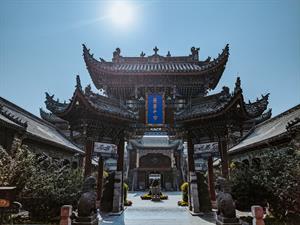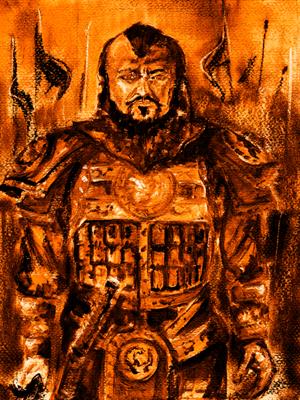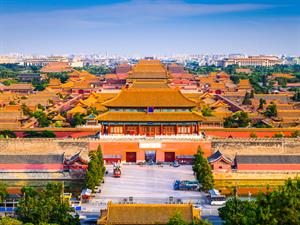PDF chapter test TRY NOW
The Rise of Sung Dynasty \text{(960 BC – 1279 BC)}:
The An-Lushan rebellion, which shook the last rulers of the Tang dynasty, succeeded in overthrowing the dynasty. The Chinese empire was bifurcated among various small empires.
The Sung dynasty, which rose to power in \text{960 BC}, had an excellent task of unifying the empire under a single rule, which it managed to accomplish under its reign.
Sung Dynasty: It was established by general Zhou Kuangyin, who was later accepted as the ruler by the army. He is also known as “Taisu” or the “Grand Progenitor”.
Rule under Sung Dynasty:
The Sung dynasty was left with an uphill task of consolidation of its empire, which they managed to complete. Post the consolidation, it tried to improve the state's economic conditions with the flourishing Iron and Steel industry.

Kaifeng City
Kaifeng: The city of Kaifeng was the most important trade centre under the Sung dynasty. It exported silk, printing paper, Porcelain and ceramic goods.
People of the lower strata suffered a lot under the rule. On the other hand, people belonging to affluent strata became even richer under the Sung dynasty.
Yuan Dynasty of Mongols (1279 BC – 1368 BC):
After overthrowing the Sung dynasty by its invasion tactics, the Mongols marched further through the lands of China. The real threat emerged when Kublai Khan, the Mongol ruler, set his sights on the Yangtze River and its southern territories.
Yuan Dadu: Kublai Khan established the Yuan dynasty with Yuandadu as its capital, later renamed Beijing.
At this time the Mongol empire had occupied 1/5^{th} of the entire world and took the innovations of the Chinese to the length and breadth of its territories.
The social condition under the Yuan dynasty:
The social conditions that prevailed under the Yuan dynasty were highly precarious as the poor, and the peasants suffered equally under their reign.
The rulers were highly ambitious in expanding their territories and left their subjects in dismay, which later led to rebellions.
The Khitan Invasion and the fall of Sung:
The Khitans were superior horsemen who controlled the northern parts of the Great Wall of China and set their eyes on the Sung dynasty. They invaded the Sung dynasty and compelled them to pay tribute.
This invasion was later followed by the nomadic Mongol tribes, which unleashed its wrath on the Sung Dynasty that led to its fall.
Lack of political unity, less military innovation and unholy formations of factions were the reasons for the fall of the dynasty.
Yuan Dynasty of Mongols: ({1279 BC – 1368 BC)}
After overthrowing the Sung dynasty by its invasion tactics, the Mongols marched further through the lands of China. The real threat emerged when Kublai Khan, the Mongol ruler, set his sights on the Yangtze River and its southern territories.

Kublai Khan
Yuvan Dadu: Kublai Khan established the Yuan dynasty with Yuandadu as its capital which was later renamed Beijing.
At this time the Mongol empire had occupied 1/5^{th} of the entire world and took the innovations of the Chinese to the length and breadth of its territories.
The social condition under the Yuan dynasty:
The Social conditions that prevailed under the Yuan dynasty were highly precarious as the poor and the peasants suffered equally under their reign.
The rulers were highly ambitious in expanding their territories and left their subjects in dismay which later led to the rebellions.
Marco Polo: An Italian merchant and traveller who visited and wrote about China under the Yuan dynasty.
The Red-Turban rebellion:
The Red – Turban army was originally formed to resist the Mongol power, which collected the dejected peasants to overthrow the Yuan dynasty.
The people of this army used Red Banners, which brought them the name of Red – Turbans. The army was headed by “Chu Yuan Chang”.
The famine and flooding further aggravated the conditions of the peasants, which made them revolt under the Red-Turbans, and this led to the overthrowing of the Yuan dynasty.
The Ming dynasty (1368 – 1644)
Post the downfall of the Yuan dynasty; the Ming dynasty came into existence which gave more importance to agricultural development than other industries.
Economic prosperity reached its height despite the invasion of foreign powers and internal strife.

Forbidden city
Forbidden city: The imperial city was built by emperor Yongle of the Ming dynasty in 1406 at the heart of Beijing city. The city was named so that the common people were prohibited from accessing this place.
The Ming dynasty fell to the age-old practices of abusing power, fighting for factions, uncalculated spending and rebellions. The lack of stable rulers and low industrialisation also brought curtains to the dynasty.
